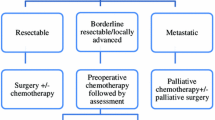Abstract
The value of standard Pancreaticoduodenectomy for Periampullary carcinomas has long been a matter of debate. Though the mortality has dramatically reduced in high volume centers with dedicated hepatobiliary surgery units, the rate is still high in peripheral institutes. In this study our aim was to access the overall post operative outcome associated with pancreaticoduodenectomy performed in a government medical college. A total of 44 patients who underwent pancreaticoduodenectomy for operable periampullary cancers were evaluated. The overall morbidity rate was 31.1%. A total of 13 (29.5%) died following the operation and of its complications though the rate has reduced drastically to 14.2% in2008. The average length of hospital stay was 22 days. The mean survival was 15 months. Pancreaticoduodenectomy can safely be performed in government medical colleges with good results. In view of the majority of the patients in rural and suburban communities, not all patients need referral to higher centers.

Similar content being viewed by others
References
Crile G (1970) The advantages of bypass operations over radical pancreaticoduodenectomy in the treatment of pancreatic carcinoma. Surg Gynecol Obstet 130:1049
Yeo CJ, Sohn TA, Cameron JL et al (1998) Periampullary adenocarcinomas; analysis of 5yr survivors. Ann Surg 227:821–831
Yeo C, Cameron JL, Sohn TA, et al (1997) Six hundred fifty consecutive pancreaticoduodenectomies. Pathology,complications,outcomes. Ann Surg 248–260
Birkmeyer JD, Siewers AE, Finlayson EVA et al (2002) Hospital volume and surgical mortality in the United States. N Engl J Med 346:1128–1137
Birkmeyer JD, Warshaw AL, Finlayson SR et al (1999) Relationship between hospital volume and late survival after pancreaticoduodenectomy. Surgery 126:178–183
Edge SB, Schmieg RE, Rosenlof LK et al (1993) Pancreas cancer resection outcome in American university centers. Cancer 71:3502–3508
Balcom JH, Rattner DW, Warshaw AL et al (2001) Ten-year experience with 733 resections: changing indications, older patients, and decreasing length of hospitalization. Arch Surg 136:391–398
Sohn TA, Yeo CJ, Cameron JL et al (2000) Resected adenocarcinoma of the pancreas-616 patients: results, outcomes, and prognostic indicators. J Gastrointest Surg 4:567–579
Wade TP, Radford DM, Virgo KS et al (1994) Complications and outcomes in the treatment of pancreatic adenocarcinoma in the United States veteran. J Am Coll Surg 179:38–48
Jagannath P, Shrikhande SV (2003) Current options in the diagnosis and management of periampullary carcinoma. Ind J Surg 65:347–353
Maingots abdominal operations, 11th ed, cancers of pancreas and other periampullary cancers,ch 41:pp 1032–1034
Yeo et al (Sep, 1997) Ann Surg 226(3):248–257
Yeo CJ, Barry MK, Sauter PK et al (1993) Erythromycin accelerates gastric emptying following pancreaticoduodenecomy: a prospective, randomised placebo controlled trial. Ann Surg 218:229
Cullen JJ, Sarr MG, Ilstrup D (1994) Pancreatic anastomotic leak after pancreaticoduodenectomy; incidence, significance and management. Am J Surg 168:295–298
Lin JW, Cameron JL, Yeo CJ et al (2004) Risk factors and outcomes in post pancreaticoduodenectomy pancreaticocutaneous fistula. J Gastrointest Surg 8:951–959
Bassi C, Dervenis C, Butturini G et al (2005) Post operative pancreatic fistula: an international study group (ISGPF) definition. Surgery 138:8–13
Van Berge Henegouwen MI, De Wit LT, Gouma DJ et al (1997) Incidence, risk factors, and treatment of pancreatic leakage after pancreaticoduodenectomy: drainage versus resection of the pancreatic remnant. J Am Coll Surg 185:18–24
Yang Y-M, Tian X-D, Zhuang Y et al (2005) Risk factors of pancreatic leakage after pancreaticoduodenectomy. World J Gastroenterol 11:2456–2461
Shrikhande SV, Friess H, Buchler MW (2008) Surgery of pancreatic tumors 15:167
Author information
Authors and Affiliations
Corresponding author
Rights and permissions
About this article
Cite this article
Patra, D.P., Basu, A., De, S. et al. Pancreaticoduodenectomy in a Government Medical College—Should We Proceed!!!. Indian J Surg 72, 381–385 (2010). https://doi.org/10.1007/s12262-010-0153-x
Received:
Accepted:
Published:
Issue Date:
DOI: https://doi.org/10.1007/s12262-010-0153-x




